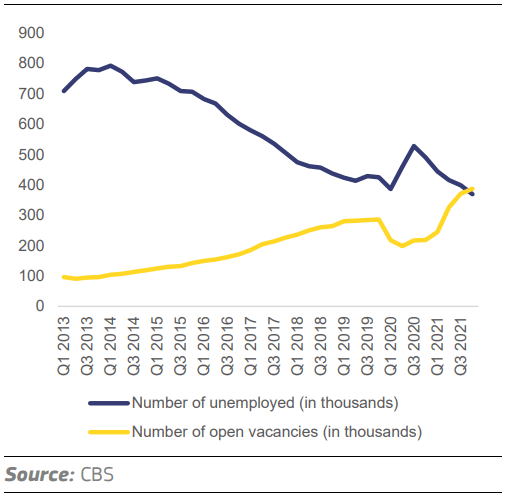The Netherlands led the competitiveness in the labor market according to a classification prepared by the Institute for Management Development (IMD, for its acronym in English), based in Switzerland.
In that ranking, the World Competitiveness Ranking 2022, the Netherlands achieved the first position among 63 world economies evaluated.
The Netherlands registered a labor force of 9.34 million people in 2020, reaching position 28 globally in this indicator.
Likewise, the Netherlands was ranked 24th in female labor force (46.9% of the total), 10th in skilled labor, and 18th in labor force growth (0.44 percent).
The Dutch economy has quickly recovered from the Covid-19 pandemic.
Consumer spending in particular rebounded quickly, with the vaccination campaign in the first half of 2021 allowing the economy to reopen again.
Number of unemployed and number of job vacancies (in thousands)
The recovery in world trade translated into strong exports and net trade that contributed significantly to GDP growth.
At the same time, investment activity was affected by supply-side constraints, mainly due to labor shortages and global supply chain disruptions.
Despite new restrictions brought about by the Omicron variant in the fourth quarter of 2021, overall GDP growth in 2021 was strong, reaching 5.0%, according to the European Commission.
Netherlands
The European Commission reports that the labor market in this economy is performing well overall, but challenges persist with growing labor and skills shortages and labor market segmentation.
Unemployment in the Netherlands fell from 4.7% in 2020 to 4.2% in 2021.
Furthermore, the number of job vacancies has even exceeded the number of unemployed in the last year.
As a result, employers are finding it increasingly difficult to find people with the right skills.
Wage growth is gradually picking up, and the European Commission expects it to continue into 2022 and shortages are likely to persist.
In particular, the high level of flexible employment requires further attention in terms of equal opportunities in the labor market, fair working conditions, adequate social protection, as well as its contribution to slow productivity growth.
![]()

